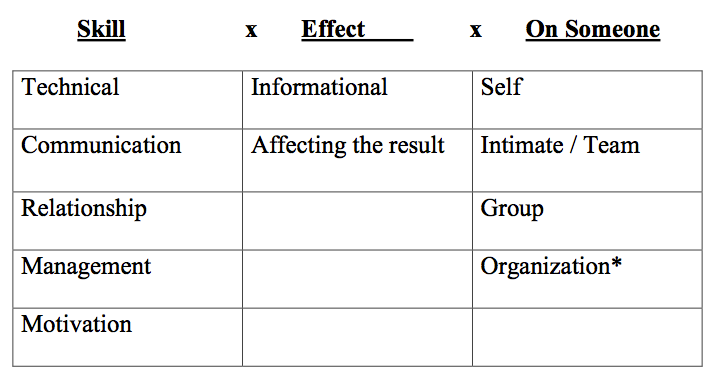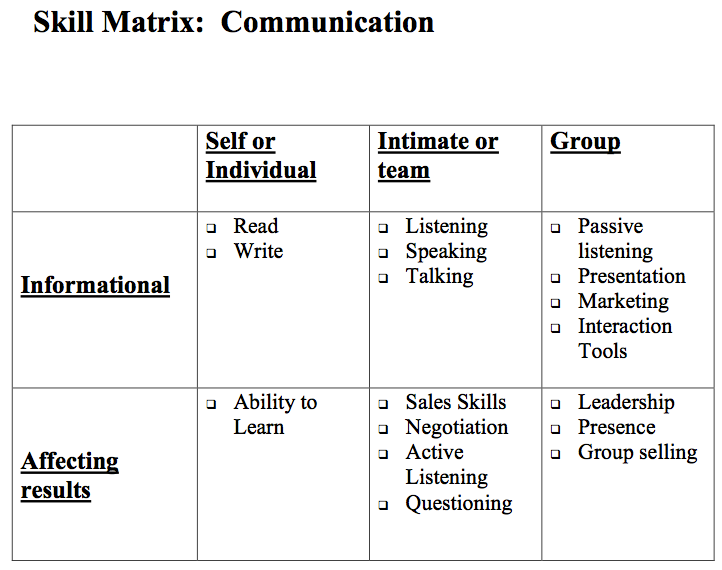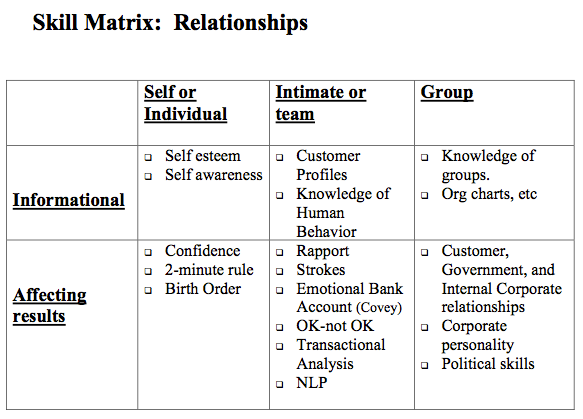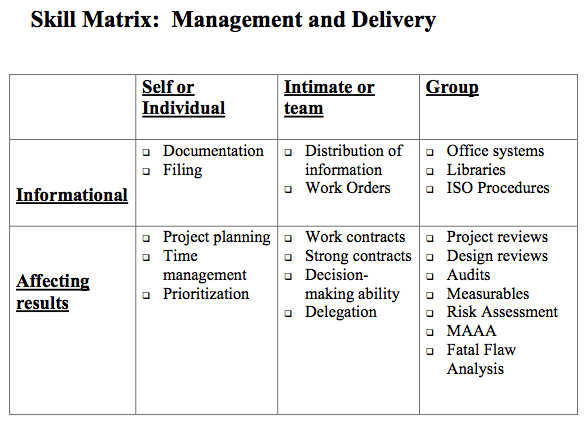1. Big Picture of Effectiveness![]()
2. Survey of Wasted Time and Efforts
3. Characteristics of Effective Persons and Organizations
4. Attitudes, Behaviors, Skills, and Values
5. Cornerstones of Competence
6. Where Do you Learn This stuff
7. Skill Effectivity
8. Skill Matrix
9. What to Do About This
10. How the Organization Impacts Effectiveness
11. Organization’s Skill Matrix
12. What Does all This Mean
13. My Experience as an Entrepreneur and Manager
14. Conclusions
1.Executive Summary:
In the future, that “big sucking sound” as Ross Perot called it, will affect white collar jobs, not just manufacturing jobs. As a technical professional, you compete with engineers from other cultures, who are a LOT LESS EXPENSIVE. These competitors are becoming more educated and better trained, and we in the US are providing this education. In order to “keep the business”, i.e. keep your job in the US, you will have to be more effective and more efficient than your worldwide competitors. Effectiveness is simply what you produce, divided by what you cost.
Among technical organizations, some are more effective than others. Some have effective organizations; others are staffed with outstandingly effective individuals. This section presents the results of a look at what makes certain technical organizations and technical personnel particularly efficient and effective. The work is based on studies of successful and, importantly, unsuccessful entrepreneurs and business leaders.
This work presents the essence of effectiveness as a fundamental skill set, and provides a methodology for benchmarking your individual effectiveness, and your organization’s effectiveness. The results provide a framework for determining further personal development, and how to put together a team to compliment your skills.
The Big Picture of Effectiveness
A technical organization is a collection of individuals, trying to compete for resources in a competitive world.
In order to determine the effectiveness and efficiency (e^2) you must know:
1. How good are the people individually?
2. How effectively do they work together as an organization?
3. How well do they compete in their particular niche.
Both the individuals and the organization must be effective.
You need a “Context” for effectiveness in order to discuss it. Our
context is a successful technical business.
There are 3 areas where lack of skills or understanding impacts
effectiveness.
• Business Issues: The rules of the forrest. This is the world in which you are competing. Lack of understanding about how a business works, what’s important in the business, and best practices pertaining to the business, can be fatal
• Organization Issues: This is your tribe. It has rules, customs, beliefs, and rituals. Violate them you will be ostracized. If they are inappropriate to the business, or if the organization wastes valuable resources, the organization is not competitive, and you all die.
• Personal Skills: This is the tool set you bring to contribute to the organization’s success. If these skills are useful, you thrive. If not, you starve.
2.Survey of typical “wasted time and efforts”:
1. Causes of “waste” in a technical organization:
a. Working on the wrong problem
b. Customer never wanted the product in the first place
c. Inefficient processes
d. Poorly defined deliverables
e. Cover your A** efforts
f. ________________
2. Estimates of Waste
a. Range from 20% to over 50%
b. General consensus that waste is over 30%
c. Tests (at MIT) show you can get rid of >30% of your expected efforts easily (with some training)
3. What happens if you can reduce this significantly?
a. Saves $$. Do more without additional cost
b. Morale goes up
c. Employee satisfaction goes up
4. What is the “root cause” of this waste
a. Lack of individual skills
b. Poor training
c. Lousy organizational tools
d. Lack of understanding about the business
3.Characteristics of an Effective Person
(Representative list from other sessions)
• Listens
• Focused
• Confident
• Clear goals and objectives
• Common Sense
• Passionate
• Proactive, takes initiative
• Clear communicator
• Simplifier
• Competent
• Trustworthy
• Trusts others
• Strong Values
• Charismatic
• Delivers results
• Team builder
• Strong values and beliefs
• Delegates well
• ___________________
• ___________________
• ___________________
• ___________________
• ___________________
• ___________________
• ___________________
Characteristics of an Effective Organization
• Strong Corporate Culture
• Good people (no incompetents)
• Focused
• Diverse
• Open, Trusting, Fair
• Common Goals and Vision
• Strong teamwork
• Non-Political
• Decisive
• Care about their employees, customers
• Reward structure linked to performance
• Clear Measurables
• Clearly delegated authority to act
• Good systems and procedures
• No micro-management
• Long term view
• ___________________
• ___________________
• ___________________
• ___________________
• ___________________
• ___________________
4.Skills, Attitudes, Behaviors, and Values
Effectiveness is a set of specific skills, attitudes, behaviors, and values.
Most people make judgments of your effectiveness based on your attitudes and behaviors.
• The Values have to be there. They guide the attitudes and behaviors
• The Skills are necessary to support the behaviors and attitudes
• Leadership Training programs, such as Covey, teach Values, Behavior and Attitude; but give little guidance on “Skills”. (except time management)
• Sales training programs, such as Sandler, teach Techniques, Behavior and Attitude; but get bad marks for “lack of values”
It is very important to develop the Skills of Effective Behavior
Your Personal skills
The Organization’s skills
The Corporate Culture
• For effectiveness, you must address all 4 issues
• There are benchmarks for effective skills and techniques
5.Cornerstones of Competence:
1. One must have a core competence. For a technical person/business this is your profession or product.
2. One must be able to sell this competence. There are a lot of engineers painting houses.
3. One must have someone to sell it to. One must have the skills to develop and maintain business relationships. These skills can be taught, even to engineers. These include both external relationships, (customers), and internal relationships (your Boss, organization, the Gov’t)
4. One must deliver this competence you sold to someone, to his expectations. If you do not execute to your customer’s expectations, you lose their trust, and don’t get another chance. This is Management.
5. On top of these cornerstones, is Motivation. Motivation is what drives you around the cycle, and makes you want to expand your core competence. Without Motivation, all the other skills are worthless.
In the following discussion; Core Competence is your “Technical Skill” set, Communication, Relationships, and Management are collectively your “People Skills”, and Motivation is “Motivation”.
• List the flaws of some ineffective people. In which category are these fatal flaws?
6.Where Do you Learn This stuff
1. Technical skills
a. University
b. Assignments on the job
c. Assimilation of corporate knowledge
d. Corporate training
e. Continuing education
2. People Skills
a. Family upbringing
b. Social training and experience
c. Schooling
d. Assimilation of corporate culture
e. On the job training (experience)
f. Mistakes and blunders
3. Motivation
a. Personal goals
b. Individual situation (e.g. expenses)
c. Psychic contract and Family Destiny
d. Birth order
e. Corporate culture
f. Reward structure
g. Peer pressure
h. (Performance reviews)
7.Skill Effectivity
This basic “skill effectivity” can be expressed as: “The Skill has a direct effect on someone(s)”.
Effect:
• Informational: = Filling the data banks, often tactical issues
• Affecting the results: = Making things happen, often strategic issues
Someone:
• Self: = Your personal experience
• Intimate / Team = one-on-one interactions and small group interactions, where “connectedness” is important
• Group = Large number of people, where individual connectedness is not expected
• Organization = Collection of a lot of groups (* Not addressed separately at this time. Combined with group for now.)
8.Skill Matrix: Core Competence
• You can have a lot of corporate knowledge, but if it is not implemented in standards, expert systems, and benchmarking, it will not be used consistently.
• You can have a great education, and a Ph.D. in whatever, but without a good engineering feel and common sense, you SHOULD be painting houses.
Skill Matrix: Communication
• If Colin Powell were in the room, the group will do what he wants, without him saying anything. He controls and communicates through his body language (presence).
• A typical mistake: “Our sales are lousy, let’s send everyone to a presentation class”.
Skill Matrix: Relationships
• This is the most difficult area for technical personnel to address.
• It is the one area where a little effort gives the most payback. In
the country of the blind, the one-eyed man is king.
Skill Matrix: Management and Delivery
• An effective person will ASK FOR regular reviews and audits
• The way you give and receive work has the largest impact on your effectiveness
• Audits (reviews) MUST happen, and MUST have “teeth”
• You must communicate your results. Measurables on the walls.
• A lack of procedures and training in these procedures is a common cause of ineffectiveness (ISO 9000 tries to address this).
Skill Matrix: Motivation
• An unmotivated person cannot be effective.
• It is imperative that the corporate reward systems, culture, mission, values, vision, etc be consistent, and aligned. If they aren’t, craziness ensues.
9.What to do about it
For each of these skills, there is a six step program to improve effectiveness:
1. Audit current performance relative to best practices. (How bad are you?)
2. Perform a Cost / Benefit analysis of deficiencies, (is it worth fixing?)
3. Develop a Strategic Plan. (How good do you want to be, when, and how?)
4. Write procedures for standardization and improvement. (What we will do.)
5. Train everyone. (Get everyone on the same page)
6. Perform Audits. (Make sure that what was learned affects a change in behavior)
For a long term, lasting impact, the behaviors must become part of the corporate culture.
For this to happen, top management has to be signed on.
10.How the organization impacts effectiveness
There are 3 issues of e^2 for an individual working in an
organization.
1. How good is he when you hire him (previous training and baggage)
2. What happens to him after hiring (training and growth)
3. Does the organization make him smarter or stupider (support, systems, and culture)
You can affect the e^2 in your organization by:
1. Hiring practices; (filter for e^2)
2. Training; (teach for e^2)
3. Organization tools (manage and assist for e^2)
11.Organization’s skill matrix
One should have product or process for each box in the matrix: e.g.
• Intellectual Property management
• Office systems
• People skill training
• An effective hiring screening process
If one doesn’t have a product for each box, one should find an outsource provider, and make it part of standard procedures and training.
12.What does all this mean (some observations)
1. Most organizations do not have an effective hiring program. Hiring is usually on “informational technical skills”. Failure is almost never on these technical skills.
2. Conventional training is usually on “informational” issues, not “effectiveness” issues.
3. Most training is “soon forgotten”. It seldom impacts behavior.
4. Measurables are often on informational issues
5. Everyone has areas where they are strong and areas where they are weak. The most effective know their strengths and weaknesses, and know when to get help, and how to listen. (This is called SYNERGY)
6. Incompetent people almost always believe they are more competent that the competent people. (They lack the “market checking” process).
7. Hubris is the enemy of effectiveness.
13.My experience in building, running, selling, and integrating a company with the new owner
What we did well:
• Testing as part of interviewing
• Trying to filter on Common sense
• Sales Training
• Work Contracts
• Corporate Culture
• Reward System
• Belief System
• Strategic Plan
• Measurables
• Office systems
What we did poorly (or could have done better):
• Collecting Corporate Knowledge
• Customer relationships
• Internal relationships
• Up-Front contracts
• Project and design reviews
In the end, poor “Internal Relationships” had a major negative
impact on the business, (from which the business eventually recovered).
14.Conclusions
1. Effectiveness is a set of skills, attitudes, behaviors, and values.
a. They are not innate
b. They can be taught
c. They can be reinforced by your corporate culture
2. You must learn to benchmark yourself and your organization, constantly
3. You must acknowledge your weaknesses and your strengths
4. You should focus on achieving a proper balance in all areas:
a. Core Competence
b. Communication
c. Relationships
d. Management
e. Motivation
5. You must Audit
a. Test to be sure key knowledge base is secure
b. Repeat at intervals (random testing)
c. The Audit must have “teeth”
6. The costs of ineffectiveness and inefficiency are myriad
a. The direct costs can be > $50,000 per year/ person
b. Indirect costs include low moral
Conclusions (cont.)
In order to change your behavior, you must want to change, have knowledge as to how to change and know what to change to.
To impact the effectiveness of an organization, you need to train over an extended period. Everyone must be trained, so the skills become “Corporate Culture”. It is NOT SUFFICIENT to just train your managers. (however, it is a disaster if the managers are not also trained, and on the same page).
Our approach is to teach a spectrum of skills and best practices, that cover the whole range of “what’s important”. This let’s you see the interrelationship of the various skills. The material comes from “standard material” that never makes it into a Technical Education. (You can study it as part of a degree in psychology; but the amount one needs to be effective is not a lot.)
We introduce much of the material as a set of tools, including:
• Fatal Flaw Analysis
• Checklists
• Strong Contracting
• Attribute Assessment Analysis
• Decision making
• Risk Assessment
• Role Playing
• Pain Questions
• Customer Profiles
• Redirecting / Reversing
• Reverse Psychology








